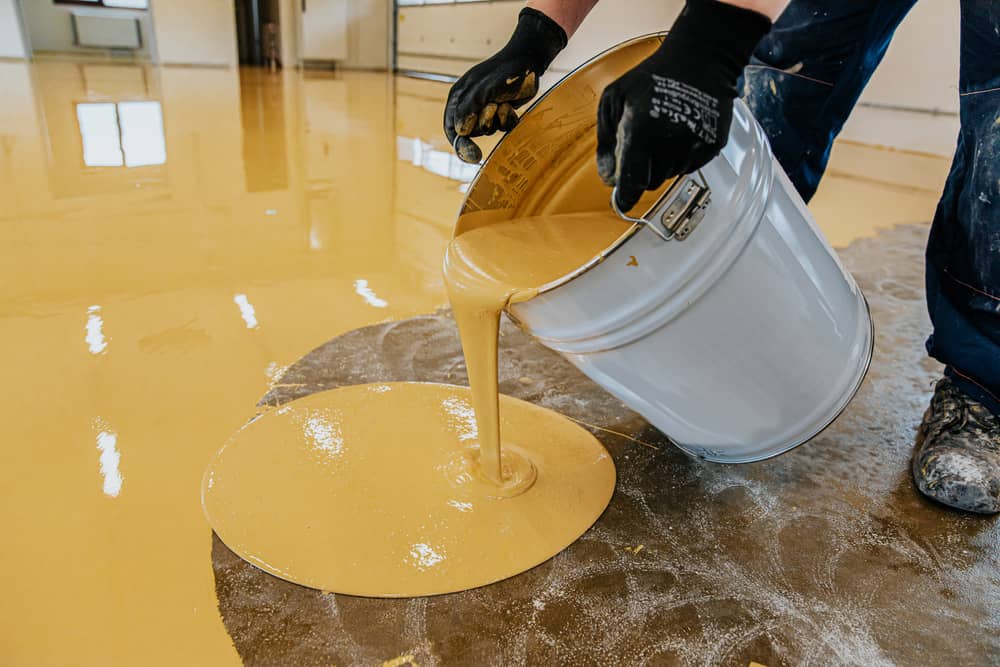Maintain your garage spotless with an Epoxy-Coated Floor setup
Maintain your garage spotless with an Epoxy-Coated Floor setup
Blog Article
The Comprehensive Guide to Comprehending Epoxy Floor Covering Options and Applications
When it involves floor covering solutions, epoxy stands apart as a versatile and resilient choice, suitable for a variety of atmospheres from commercial facilities to residential properties. The globe of epoxy flooring is detailed and varied, with various kinds each serving distinct functions. As such, making an informed decision needs a much deeper understanding of the advantages and disadvantages, sensible applications, and the actions to preserve such a flooring remedy. Browsing the subtleties of epoxy flooring can be a journey of exploration, offering understandings into a realm usually ignored.

Untangling the Fundamentals: What Is Epoxy Flooring?
Epoxy flooring, a term frequently listened to but seldom dissected, describes a flooring surface that is composed of multiple layers of epoxy put on a flooring with a deepness of a minimum of two millimeters. Epoxy, a two-part system containing resins and hardeners, creates a solid, immune, and durable layer when mixed with each other. Its resilience and resistance to grease, oil, and other kinds of chemical spills make it a preferred flooring option for business and industrial areas. Its aesthetic charm has not been overlooked, leading to its increased usage in residential rooms. Besides its strength and resilience, epoxy floor covering is additionally very easy to keep, needing marginal maintenance. Nonetheless, its installation calls for a porous and clean surface for appropriate adherence, demanding professional intervention.
Different Kinds of Epoxy Floor Covering Solutions
While there is a basic understanding of what epoxy flooring is, many may not understand that there are several various kinds of epoxy flooring services offered. An additional kind is quartz-filled epoxy, which blends high-performance epoxy polymer material with stained quartz grains for decorative spaces requiring slip-resistant and sanitary buildings. Each kind serves particular needs, making sure epoxy floor covering caters to numerous needs.
The Benefits and drawbacks of Epoxy Flooring
In spite of its various applications, epoxy floor covering is not without its negative aspects and benefits. Its pros consist of longevity, resistance to use, and lasting shine, making it an optimal choice for high-traffic areas. Epoxy floor covering is likewise immune to most sorts of problems, including those brought on by chemicals, water, and heat, which contributes to its charm.
Nevertheless, the application process is labor-intensive and calls for a dry and tidy surface, which can be a deterrent for some. In addition, epoxy floor covering can be slippery when wet, posing a safety threat. Its solidity, while a strength, can also be a drawback as it can be unpleasant for meaning extended periods. Last but not least, its aesthetic Epoxy Garage Floor appeal might fade in time, calling for reapplication or replacement.

Practical Applications of Epoxy Floor Covering in Various Industries
Working as a stalwart in various sectors, epoxy flooring finds its functionality in a diverse variety of markets. In the automotive market, it is made use of because of its resistance to oil and chemical spills, which are usual in garages and showrooms. The medical care industry, including healthcare facilities and centers, values its easy cleansing and sanitizing residential or commercial properties, vital for preserving a sterile environment. In the manufacturing market, epoxy floor covering's toughness and resistance to heavy machinery makes it a favored selection. The food and beverage market values it for its capability to withstand bacterial growth and fulfill hygiene criteria. Thus, the adaptability of epoxy flooring makes it a sought-after solution across different sectors.

Steps to Mount and Keep Your Epoxy Floor Covering
Offered its considerable applications throughout different markets, it stands to reason that the proper installation and maintenance of epoxy flooring is of vital significance. Installment needs a tidy, completely dry surface area, commencing with the elimination of any old paint or sealant, followed by detailed cleaning and drying. Epoxy Finish Garage Floor. Next off, the epoxy mixture is prepared, used, and allowed to cure
Normal upkeep makes certain longevity and preserves the visual appeal of the flooring. Thus, correct setup and persistent upkeep are important for optimum efficiency of epoxy floor covering.
Final thought
In recap, epoxy floor covering offers a versatile and long-lasting solution for a broad array of spaces. Understanding the various epoxy flooring alternatives and their applications can assist you to the optimal service for your room, guaranteeing a flooring investment that incorporates sturdiness, capability, and aesthetic allure.
Epoxy flooring, a term commonly listened to however hardly ever read dissected, refers to a floor covering surface area that consists of several layers of epoxy applied to a flooring with a depth of at the very least two millimeters.While there is a general understanding of what epoxy floor covering is, many might not realize that there are a number of various types of epoxy flooring services readily available. An additional type is quartz-filled epoxy, which blends high-performance epoxy polymer material with stained quartz grains for ornamental rooms needing slip-resistant and sanitary properties.Provided its wide-ranging applications across different fields, it stands to factor that the proper installation and maintenance of epoxy flooring is of paramount relevance. Understanding the different epoxy flooring options and their applications can direct you to the optimal solution for your area, guaranteeing a flooring investment that integrates resilience, functionality, and next aesthetic allure.
Report this page